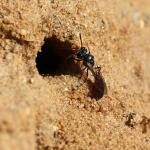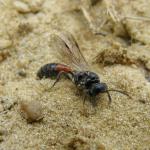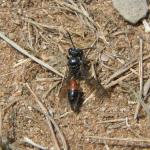Mimesa basirufa PACKARD 1867; Mimesa bicolor misident.; Psen dispar GUSSAKOVSKIJ 1937; Mimesa mallochi FINNMORE 1980; Mimesa nebrascensis SMITH 1908; Mimesa shuckardi WESMAEL 1852
A small, ground nesting red and black solitary wasp. Identification keys are given in Richards (1980) (as Psen lutarius), Lomholdt (1984) (as Mimesa lutaria) and Yeo & Corbet (1995) (as Psen lutarius).
Widely recorded from scattered localities in southern Britain and north to south Yorkshire.
Overseas found widely distributed throughout Europe and Asia through to Japan.
Found in a range of open habitats with light soils such as heathland; occasionally recorded from coastal dunes.
Univoltine; June to September.
Nest burrows are stocked with a range of small homopteran bugs, usually leafhoppers of the family Cicadellidae.
Nests are dug in sandy soil in warm, sheltered situations, with nesting often occurring in small aggregations. Nests consist of a single deep vertical burrow of between 40-50cm in length, with smaller galleries ending in nesting chambers radiating from the lower part of the burrow (Lomholdt 1984).
None recorded.
None recorded from Britain. In Fennoscandia, Lomholdt cites the non-British chrysid wasp Omalus constrictus as a parasite.
2005




